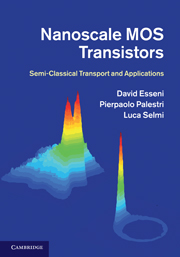Book contents
- Frontmatter
- Contents
- Preface
- Acknowledgements
- Terminology
- 1 Introduction
- 2 Bulk semiconductors and the semi-classical model
- 3 Quantum confined inversion layers
- 4 Carrier scattering in silicon MOS transistors
- 5 The Boltzmann transport equation
- 6 The Monte Carlo method for the Boltzmann transport equation
- 7 Simulation of bulk and SOI silicon MOSFETs
- 8 MOS transistors with arbitrary crystal orientation
- 9 MOS transistors with strained silicon channel
- 10 MOS transistors with alternative materials
- Appendices
- Index
7 - Simulation of bulk and SOI silicon MOSFETs
Published online by Cambridge University Press: 05 August 2011
- Frontmatter
- Contents
- Preface
- Acknowledgements
- Terminology
- 1 Introduction
- 2 Bulk semiconductors and the semi-classical model
- 3 Quantum confined inversion layers
- 4 Carrier scattering in silicon MOS transistors
- 5 The Boltzmann transport equation
- 6 The Monte Carlo method for the Boltzmann transport equation
- 7 Simulation of bulk and SOI silicon MOSFETs
- 8 MOS transistors with arbitrary crystal orientation
- 9 MOS transistors with strained silicon channel
- 10 MOS transistors with alternative materials
- Appendices
- Index
Summary
The semi-classical transport model for inversion layers developed in the previous chapters finds a natural field of application in the analysis of advanced nano-scale MOSFETs.
In this chapter we illustrate the ability of this model to describe low and high field transport in unstrained (001) silicon. To this purpose, extensive simulations are presented for the low field effective mobility of long channel devices and for the on-current of short bulk and SOI transistors. The first half of the chapter describes how the multiple and complex dependencies of the mobility on the bias, channel doping, silicon film thickness and temperature relate to the physical ingredients of the inversion layer transport model, namely the discrete energy levels, the occupation probability and the scattering rates in the subbands.
The second half of the chapter covers high field transport in uniform silicon slabs and in short channel MOSFETs. The quasi-ballistic transport model outlined in Chapter 5 guides the interpretation of the transistor simulations.
The results proposed in this chapter set a reference for the analysis of more complex cases of interest for advanced CMOS technologies. In particular, the impact on carrier transport of technology boosters such as crystal orientation, strain and alternative materials are analyzed in Chapters 8, 9, and 10, respectively.
- Type
- Chapter
- Information
- Nanoscale MOS TransistorsSemi-Classical Transport and Applications, pp. 314 - 347Publisher: Cambridge University PressPrint publication year: 2011



